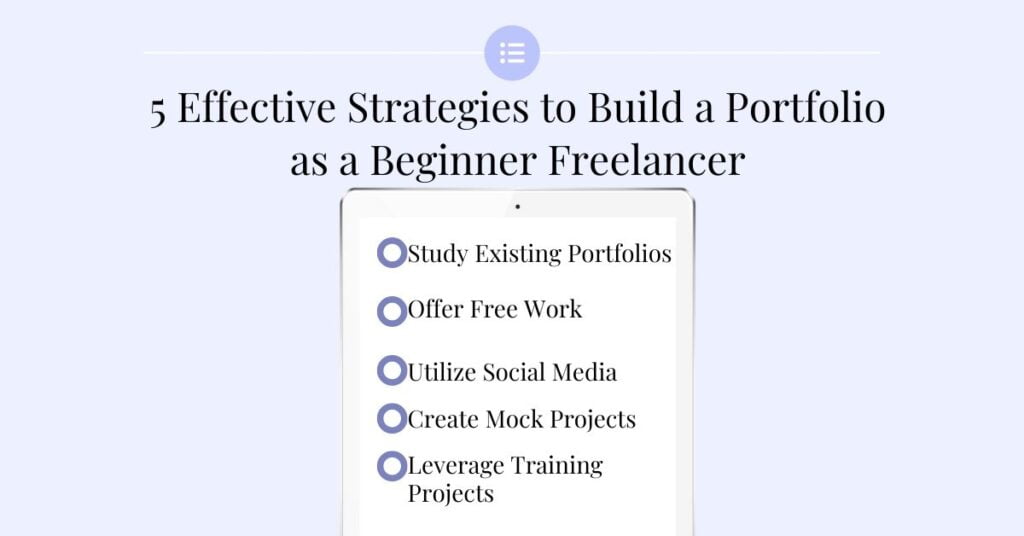In the age of remote work, every freelancing platform requires you to have a portfolio. I recommended uploading your portfolio to these platforms, but what if you’re just starting and don’t have any projects to showcase? You’re in the right place if you’re struggling with this question. This article will guide you on how to build a portfolio as a beginner freelancer.
Importance of a Portfolio
A portfolio is essential for freelancers. It serves as a visual representation of your skills and expertise, helping potential clients see what you can do. With a portfolio, convincing someone to hire you becomes significantly easier. So, how do you build a portfolio from scratch? Here are some effective strategies to build a portfolio as a beginner freelancer.
5 Effective Strategies to Build a Portfolio as a Beginner Freelancer

1. Study Existing Portfolios
The first step is to see how portfolios are made in your field. You can find templates on platforms like Canva or hire a professional to create one for you. Additionally, explore profiles on freelancing sites like Fiverr or Upwork. Look at the portfolios of top sellers in your niche to understand what makes them stand out. This will give you a clear idea of what clients expect and how you can present your work effectively.
2. Offer Free Work
One of the most effective ways to build a portfolio is by offering free work. Reach out to local vendors, small business owners, startups, or even popular businesses in your area that lack an online presence. Offer to create a website, design a logo, or provide SEO services for free. This strategy not only helps you build a portfolio but also allows you to gain practical experience. Remember, in the world of freelancing, time is just as valuable as money. You can create a portfolio showcasing your skills by investing your time.
3. Utilize Social Media
Join Facebook groups and other social media communities related to your field. These platforms often have people posting their requirements. Offer your services for free in exchange for using the work in your portfolio. While it’s not advisable to take on large projects for free, small tasks like designing a logo or creating a simple website can be done at no cost. These small projects can significantly enhance your portfolio.
4. Create Mock Projects
If you can’t find real clients, create mock projects. These are hypothetical projects that demonstrate your skills. For example, design a logo or build a website for an imaginary business. While these aren’t real projects, they still showcase your abilities and can be included in your portfolio. This approach is particularly useful for demonstrating your creativity and technical skills.
5. Leverage Training Projects
Include any projects you’ve completed during training or while learning a new skill. These projects might not be for real clients, but they still demonstrate your capability. Whether it’s a website you built during a course or a logo you designed as part of an assignment, these can all be part of your portfolio.
Conclusion
In conclusion, Building a portfolio as a beginner freelancer might seem challenging, but it’s entirely possible with the right approach. By studying existing portfolios, offering free work, utilizing social media, creating mock projects, and leveraging training projects, you can create a portfolio that effectively showcases your skills. Remember, a strong portfolio is key to attracting clients and achieving success in freelancing. So, invest your time and effort into building one, and you’ll soon see the benefits.
FAQ’S
If you want to build a freelance portfolio without prior experience, you can begin by providing free services to local businesses or startups. In return, ask for permission to feature the work you complete. You can also create sample projects that showcase your skills and include any assignments or projects you worked on during training or courses. These approaches will help you create a portfolio that effectively demonstrates your abilities.
Mock projects are hypothetical assignments that you create to showcase your skills. For example, you might design a logo or build a website for an imaginary business. These projects, although not for real clients, still demonstrate your capabilities and creativity, making them valuable additions to your portfolio.
Social media platforms, especially Facebook groups related to your field, can be excellent resources for finding opportunities to build your portfolio. Many people post their requirements in these communities. By offering to complete small tasks for free, you can create portfolio pieces and gain exposure. Just ensure the tasks are manageable and relevant to your skillset.



